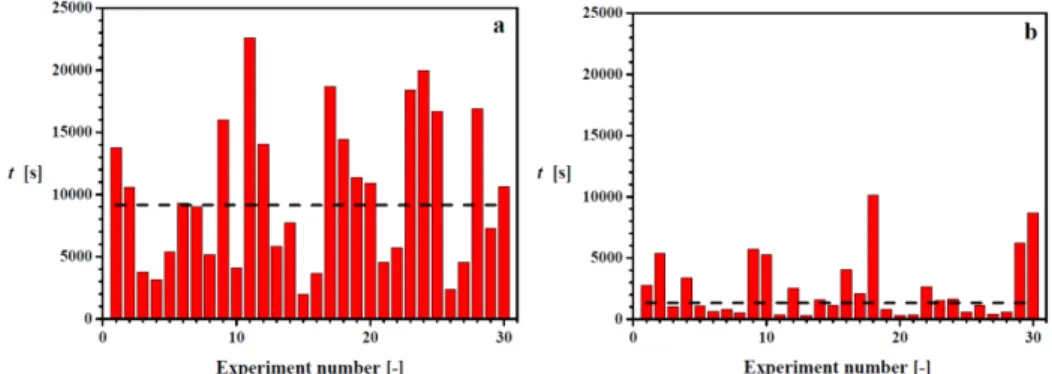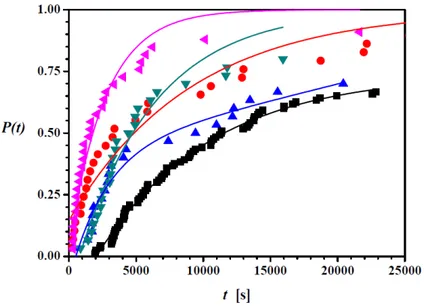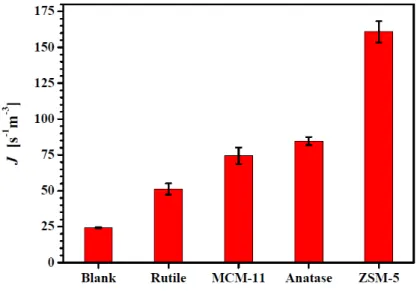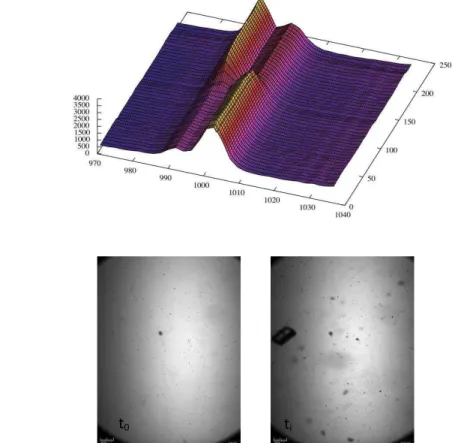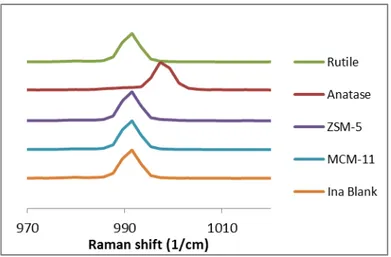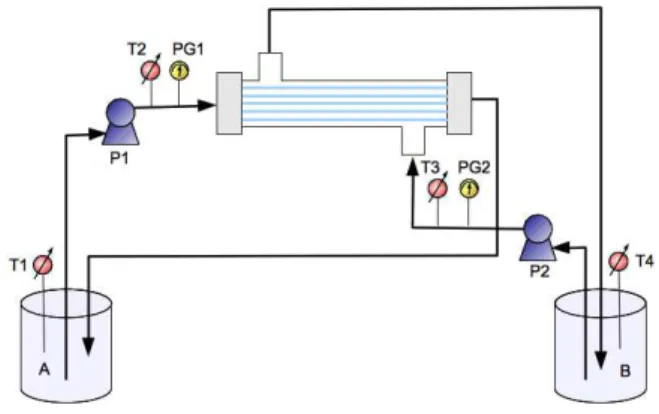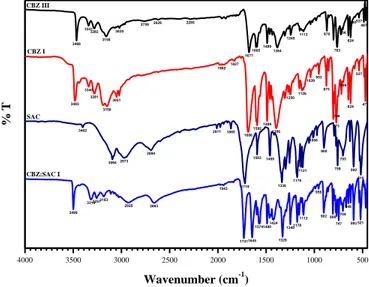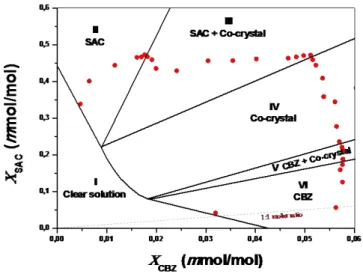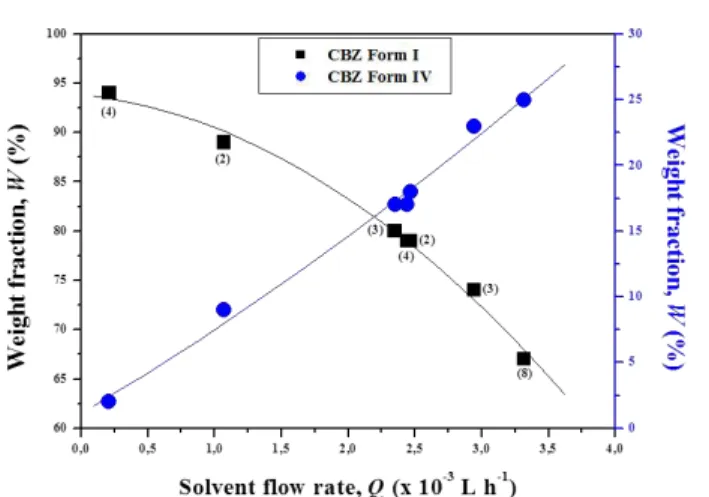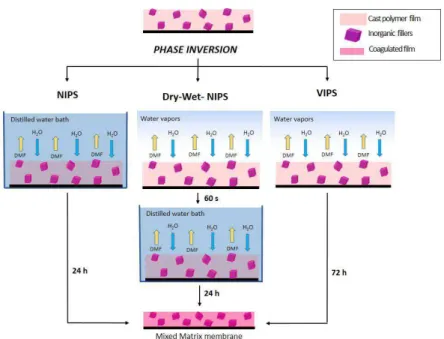UNIONE EUROPEA Fondo Sociale Europeo
REPUBBLICA ITALIANA REGIONE CALABRIA Assessorato Cultura, Istruzione e Ricerca Dipartimento 11
Università della Calabria
DIPARTIMENTO DI INGEGNERIA PER L'AMBIENTE E IL TERRITORIO E INGEGNERIA CHIMICA
Dottorato di Ricerca in Ingegneria Chimica e dei Materiali
SCUOLA DI DOTTORATO " PITAGORA " IN SCIENZE INGEGNERISTICHE
Ciclo XXVI
Tesi
An insight on pharmaceutical crystallization
process by using membrane technology:
PVDF-based mixed matrix membranes and PP grafted membranes as new tools for controlling the supersaturation rate and the heterogeneous
nucleation mechanism.
Settore Scientifico Disciplinare CHIM/07 – Fondamenti Chimici delle Tecnologie
Supervisori
Ch.mo Prof. Enrico Drioli
Dr. Gianluca Di Profio Candidato
Antonella Caridi
Coordinatore del Corso di Dottorato
Ch.mo Prof. Raffaele Molinari
____________________ AA 2013/2014
The PhD research project was in collaboration with:
Institute on Membrane technology (CNR), Rende,IT
under the supervision of
Prof. Enrico Drioli and Dr. Gianluca Di Profio
Technische Universiteit Delft, Delft, NL
under the supervision of Prof. Joop H. ter Horst at Process & Energy
Intensified Reaction and Separation systems Department of (3mE), in the semester November 2011-April 2012
Université Paul Sabatier, Toulouse, FR under the supervision of Prof. Pierre Aimar
at Laboratoire de Gènie Chimique (CNRS) in the semester Septermber 2013- february 2014
Sommario
Questo elaborato finale del progetto di dottorato tratta lo studio del processo di cristallizzazione a membrana finalizzato alla produzione di composti farmaceutici in forma cristallina. Lo studio ha come obiettivo quello di dare una visione globale del processo di cristallizzazione a membrana andando oltre lo stato dell a te, bensì p opo e do l i ple e tazione della tecnica di cristallizzazione a membrana di base. A tal proposito il progetto è stato sviluppato seguendo in due diverse direzioni: da una parte la tecnica di istallizzazio e a e a a di ase ha isto l appli azio e ad u o spe ifi o settore dell i dust ia fa a euti a, dall alt a pa te lo studio è p oseguito investigando i meccanismi di cristallizzazione indotti dalla stessa membrana e successivamente ha visto una vera e propria progettazione di membrane opportunamente pensate per la cristallizzazione.
Du ue, il alo e aggiu to di tale studio o siste ell a e e di ost ato la possibilità di ampliare il campo di applicazione del processo a membrana, di aver esteso la conoscenza di base dei meccanismi di nucleazione eterogenea sottesi dalla membrana e di aver progettato, prodotto e caratterizzato delle membrane con differenti materiali e strutture appositamente per essere testati nella tecnica di cristallizzazione. In dettaglio, il lavoro presenta uno studio iniziale sul processo di nucleazione eterogenea che parte da particelle libere in soluzione per poi continuare studiando il processo di nucleazione eterogenea sullle membrane stesse. U a se o da sezio e t atta l appli azio e del processo a membrana alla cocristallizzazione farmaceutica. Successivamente inizia la parte di disegno e realizzazione di membrane eterogenee sia dal punto di vista chimico che strutturale: membrane fabbricate con tecniche e materiali differenti e membrane commerciali che sono state opportunamente funzionalizzate. Infine il lavoro si conclude con i tests di cristallizzazione condotti su tali membrane.
Abstract
This is the final work of the PhD project related to the study on the membrane crystallization process used for the production of pharmaceutical compounds in crystalline form. The study aims to give an overview of the membrane crystallization process beyond the state of the art, while proposing the implementation of the basic technique. On this regard, the project has been developed following two many directions: on one hand, the basic membrane crystallization technique has extended its scope to a specific field of the pharmaceutical world; on the other hand, the study followed by investigating the crystallization mechanisms when induced by the membrane and subsequently, a real design of membranes suitably for the crystallization followed. Therefore, the added value of this study is:
- having demonstrated the possibility of expanding the scope of the membrane process;
- having extended the basic understanding of the heterogeneous nucleation mechanisms induced by membranes;
- having investigated the process of design, manufacturing and characterization of the membranes with different materials and structures, specially to be tested in the art of crystallization .
In detail, the work presents an initial study on the process of heterogeneous nucleation by particles free in solution and then, it continued by investigating the process of heterogeneous nucleation on membranes. A second section deals with the application of the membrane-based process on pharmaceutical. Then, followed the section of design and realization of membranes heterogeneous by a chemical and structural point of view; these membranes were manufactured with different techniques and different materials or were appropriately functionalized. Finally, the paper was concluded by presenting the crystallization tests performed on the produced membranes.
Index
Chapter 1: Crystallization of isonicotinamide polymorphs on heterogeneous
nucleants ... 5
1.1 Introduction ... 7
1.2 Materials and Methods ...10
1.3 Results and discussions ...13
1.4 Conclusions ...28
1.5 References ...29
Chapter 2: Membranes as tool for pharmaceutical crystallization ...31
and co-crystallization ...31
2.1 Introduction...33
2.2 Materials and methods ...35
2.3 Results and discussions ...39
2.5 Conclusions...46
2.5 References ...47
Chapter 3: Manufacturing of PVDF-based Mixed Matrix Membranes as heterogeneous support for crystallization ...51
3.1 Introduction...53
3.2 Materials and methods ...56
3.3 Results and discussion ...61
3.4 Conclusions...77
3.5 Reference ...79
Chapter 4: Development of UV-photografted membranes designed for ...81
membrane crystallization process ...81
4.1 Introdution ...83
4.2 Materials and methods ...87
4.3 Results and discussions ...91
4.4 Conclusions...101
4.5 References ...103
by means of tailor-made membranes ... 107
5.1 Introduction ... 109
5.2 Materials and methods ... 111
5.3 Results ... 112
5.4 Conclusions ... 126
In
tr
o
d
u
ct
io
n
1
Introduction
This thesis is the final product of some years of study, experiences and elaborations. It would give an overview of membrane crystallization as a whole, without getting tied to the state of the art, rather investigating some new aspects of the process, such as the use of tailor-made membranes as nucleating agent, and the application of membrane technology to specific areas of pharmaceutical crystallization.
Initially, it is addressed the heterogeneous nucleation mechanism as the central core of the crystallization process and the ability to control this mechanism for the production of specific polymorphs through the use of free templates in solution. This study proved to be of great importance for expanding our fundamental knowledge about the heterogeneous nucleation mechanism and for introducing the following studies about the nucleation process onto polymeric surfaces of the membranes. Indeed, in the first chapter, the possibility of inducing nucleation of different pharmaceutical polymorphs, by using well-defined heterogeneous templates, was investigated. Synthetic zeolites with pores of well-defined size in the nanometer range, as well as titanium dioxide in two different forms, were used as templates. These researches were carried out at Mechanical, Maritime and Materials Engineering department of the Technical University of Delft, working with a research group leader in the field of industrial crystallization. During this experience, I had the opportunity to avail of cutting-edge equipment for researching on crystallization process, as well as having interesting and educational discussions with experts in the field. Later, the study on heterogeneous nucleation has been extended to the use of the membranes as heteronucleants.
The second chapter deals with the membrane crystallization process by using commercial membranes in a basic configuration. The newness of these investigations compared with past ones was the application of the basic
concept of membrane crystallization to the pharmaceutical cocrystallization process. The new membrane-based cocrystallization strategy has been used to induce the formation of carbamazepine-saccharin (CBZ-SAC) cocrystals or carbamazepine (CBZ) and saccharine (SAC) single crystals from water/ethanol solvent mixtures depending on the initial CBZ and SAC molar ratio. This study revealed the ability of the membrane-based technique of providing specific routes in the solubility phase diagram of CBZ-SAC system when opportunely choosing the initial solution conditions. The membrane had the specific role of limiting the maximum level of supersaturation reached in solution by controlling the solvent evaporation thorough its micropores. Furthermore, it was demonstrated the influence of trans-membrane flux on the polymorphic composition of the precipitates examining how as increasing the rate of supersaturation generation an increasing of the higher energetic polymorph occurred. After having successfully demonstrated the possibility of extending the basic membrane crystallization to other pharmaceutical applications. After this, the research continued by investigating the role of the membranes as nucleating agent. The strategy of study provided two steps: the manufacturing of various membranes typologies and the testing of the produced membrane as heteronucleants during crystallization. On this regard, chapter 3 deals with the manufacturing and the characterization of PVDF-based mixed matrix membranes with four different inorganic nanosized fillers and by using three different manufacturing procedures. The goal of the work was the fabrication of many different kind of membranes heterogeneous from a chemical and structural point of view, to eventually testing their performance in pharmaceutical crystallization. The membrane manufacturing and characterization was carried out at the Institute on Membrane Technology of the Italian National Council (ITM-CNR) and at Mechanical and Materials Engineering department of University of Calabria.
After the design and fabrication of various PVDF membranes, the research continued along the road of the membrane surface modification in order to create membranes opportunely functionalized. Thus, commercial polyproprylene (PP) membranes normally used in basic membrane crystallization have been subjected to UV-photografting treatment for the
In
tr
o
d
u
ct
io
n
3
grafting of acrylic acid monomer on the surfaces, in the chapter 4. While PP is basically inert, a successful stategy allowed the formation of a thin layer of polyacrylic acid on the membrane surface, resulting in the developing of double layered membranes: hydrophilic on one side and hydrophobic on the other side. Both flat sheet membrane and hollow fibers were treated with good outcomes. This work was performed at the Laboratoire de Geniè Chimique of Universitè Paul Sabatier in Toulouse, where it was possible to design and implement the full strategy of chemical modification of the polymeric surface and the following characterization.
After that, all produced or modified membranes discussed so far, were tested in crystallization of pharmaceutical model compounds in order to investigate their performance as heteronucleants. In chapter 5 this study is detailed by evaluating the crystals nucleation density on the membrane surface considered. The following table summarize whole research project.
PhD research project PhD year University/ Institute Thesis Chapter Study details I ITM-CNR/ Unical, Italy
2 Basic membrane crystallization process and application on pharmaceutical crystallization. II TU Delft,
The Netherlands
1 Study on crystal nucleation mechanism on nanosized templates
II ITM-CNR/ Unical, Italy
3 Manufacturing of mixed matrix mebranes with nanosized fillers as heteronucleants
III UPS Toulouse,
France
4 Design and implementation of UV-photografted membranes for crystallization III ITM-CNR/ Unical, Italy 5 Crystallization of pharmaceuticals by means membranes as heteronucleant
IC
h
a
p
te
r
1
5
Chapter 1
Crystallization of isonicotinamide
polymorphs on heterogeneous
nucleants
IC
h
a
p
te
r
1
7
1.1Introduction
The first chapter deals with the potential of using well defined heterogeneous templates in controlling nucleation, as key step of crystallization process. This section aims of reasoning the fundamental aspects of the heterogeneous nucleation, which would anticipate some questions of the following sections about the crystallization process mediated by polymeric matrices such as membranes.
Nucleation is the formation of the first small crystalline embryos referred to as nuclei.1 These nuclei become stable and grow up to mature crystals upon
achieving a certain critical size.1 Because nucleation is the primary step in the
crystallization process, it determines the final characteristics of the rising crystalline phase, such us crystal size, size distribution, and polymorphism.2,3
Therefore, control of the nucleation stage is crucial for the control of the macroscopic properties of the produced crystalline materials.
Nucleation mechanism is generally recognized as homogeneous (HON) or heterogeneous (HEN). The former occurs when a sufficient number of molecules cluster together in the same region and at the same time in the course of their random movement in the bulk and are able to form a critical nucleus.1 HEN is the formation of critical nuclei at foreign body surfaces
because of the creation of reduced interfacial energy regions that lower the thermodynamic barrier to nucleation.4 HEN usually occurs in batch
crystallization processes because the solution solid impurities, the dust pa ti les o the o tai e s alls a t as hete oge eous su fa es p o oti g nucleation. Despite HEN is the dominant mechanism in solution crystallization, its control is still limited due to the ill-defined properties of the heterogeneous particles onto which HEN occurs. Also, concentration and surface of these particles are not known and/or impossible to be determined. On the other side, the opportunity to affect rationally the nucleation stage with the aid of intentionally added heterogeneous surfaces, would lead to improved control
over crystal properties. In the last years, several efforts have been devoted to the study and the development of tailored heterogeneous surfaces suitable to control nucleation for both biomacromolecules and small organic molecules. Several studies showed that the nucleation process can be modified by the presence of interfaces by various mechanisms: by means of favorable molecular interactions between the functional groups of target molecule and substrate surface; by epitaxial matching of the solute crystal lattice with the solid support; by confinement effects into porous or irregular structures. Several types of heteronucleants have been used for protein crystallization. Porous supports like porous silicon,5
carbon nanotubes,6
zeolites,7
bio-active gel glass,8 or porous polymeric membranes9,10 were effective in enhancing
nucleation rate; charged surfaces like polymeric films,11 modified mica,12
fluorinated layered silicate,13 and poly-L-lysine surface14 were used to support
the electrostatic interaction with protein functional groups. Besides, many studies highlighted the possibility to affect polymorphism of organic crystals by using appropriate heterogeneous surfaces. Polymeric films with tailored chemical and structural surface properties were developed to modulate the nucleation rate of organic materials.15,16,17 Phase-selective crystallization of
acetaminophen has been performed by Lòpez-Mejìas et al.,18 with
polymer-induced heteronucleation, and by Chadwick et al.,19 by epitaxial seeding on an
opportunely chosen crystalline substrate. The induction of specific crystal forms and the control of crystal size of molecular crystals by means of heterogeneous templates have been successfully demonstrated by using patterned self-assembled monolayers,20 porous glass,21 and cross-linked
polymer microgels with various mesh size.15
Despite the progress made in this field in the last years, the complete understanding of the fundamentals of the HEN mechanisms still remains demanding. The major challenge is to provide a description of the involved molecular mechanism and the interpretation of the structural relationships between heterogeneous surface and interacting molecules. Therefore, this work aimed to enhance the current knowledge of heterogeneous nucleation mechanisms at molecular level and to get improved control of polymorphic
IC
h
a
p
te
r
1
9
selectivity in solution crystallization, by studying the potential of properly selected heterogeneous templates to stimulate HEN.
Templates exhibiting porous and regular surfaces structures in the nanometer range were selected and their influence on the nucleation kinetics and polymorphic selectivity of the model molecule Isonicotinamide (INA) was investigated by monitoring real-time the course of the crystallization process. Association processes play a key role in the crystallization of INA.14 Among the
five different known polymorphs of INA15,16 all metastable forms I, III, IV and V
show various arrangements based on head-to-tail chains assembling of molecules, while form II, which is stable at room temperature, displays a head-to-head dimeric packing. Solvents like nitromethane and nitrobenzene enable the association of INA into chains leading to the formation of metastable forms. Solutions of INA in ethanol contain dimers and chains while crystallization using ethanol leads to the formation of the stable form II. In this paper, we investigate whether templates can counterbalance this effect of self-association in the case of INA. If templates are sufficiently effective, then, a polymorph with a structure will be formed that does not reflect the association pattern in solution. Porous and regular inorganic templates, such as synthetic zeolite ZSM-5, mesoporous aluminosilicate MCM-41, and TiO2 in
both rutile and anatase phase, were selected. We first investigated whether the templates enhance nucleation, after that, we studied the polymorphic outcome of crystallization processes.
1.2Materials and Methods
Materials. Isonicotinamide (Cod. I17451), absolute ethanol, synthetic zeolite
ZSM-5 (Cod. 419095) and MCM-41 (Cod. 643653), titanium dioxide in both rutile (Cod. 204757) and anatase (Cod. 637254) forms were provided by Sigma-Aldrich. All templates were used without further purification.
Solubility & Metastable Zone. The solubility of INA in ethanol was measured as
a function of temperature using Crystal16 setup (Avantium, Amsterdam, the Netherlands). Slurries of INA, in different overall concentrations, were prepared by adding a known amount of crystalline material to 1 mL of solvent and stirring at 700 rpm. The saturation temperature was measured 3 times per sample through cycles of heating and cooling from 10 °C to 60 °C at 0.3 °C min
-1. Upon increasing the temperature the crystals completely dissolved and the
suspension became a clear solution so that the light transmission reached the maximum value. The temperature at which light transmission reached the maximum value was the clear point, which we assumed to coincide with the saturation temperature. Then, by cooling down the solution with a rate of 0.3 °C min-1, there was a temperature at which the first formed crystals were detected by a decrease in the light transmission (cloud point). The difference between cloud and clear point defined the metastable zone width (MSZW) of the system.
Induction time. The INA concentration used in induction time (ti) experiments
was 87.5 g L-1 in ethanol, corresponding to a supersaturation ratio S of 1.25 at a temperature of 25 °C, according to the experimentally determined solubility. Induction time measurements were performed on a 1 mL scale at 25 °C using the Crystal16 reactor. Each vial was magnetically stirred at 700 rpm; the heating rate was set at 0.3 °C min-1 and the cooling rate at 5 °C min-1. Induction
times were revealed by the initial decrease in the transmission of light through the sample since crystals started to form. The induction time is the period between the achievement of constant supersaturation at 25 °C and the moment the transmission started to decrease. To perform measurement of ti
C
h
a
p
te
r
1
11
with templates, a stock solution with 0.3 mg*L-1 of templates in ethanol was
prepared. Such a low contentration of template was reached by dilutions after suspending the templates. The suspension was obtained by treating the sample ultrasonically (Bransonic 2510E-MT 42 KHz +/-6%) for 15 min to break up the possible nano-powders aggregate particles. After that, a known amount of INA was dissolved into the 0.3 mg L-1 template suspention, to make the final supersaturation of INA to S=1.25. The sample was heated and again treated ultrasonically to dissolve INA powder and disperse the template particles. A hot bottle-top dispenser platform was used to avoid crystallization of INA during sample preparation and to dispense 1 mL of nano-suspension of template and dissolved INA into each vial. The amount of templates was chosen to be sufficiently low (0.3 mg L-1) to avoid influence on the light
transmittance. Suspensions were also stirred during the induction time measurements/crystallization tests, to uniformly suspend the template particles.
Crystallization experiments. For the crystallization experiments INA
concentrations were 87.5 g L-1 and 98.0 g L-1 at 25 °C, corresponding to a supersaturation of 1.25 and 1.40, respectively, at 25 °C. Cooling crystallization experiments were carried out in the Crystalline multiple reactor setup (Avantium, Amsterdam, the Netherlands) by using 3 mL of INA solutions in ethanol with and without (blank experiments) templates. All tests were conducted under equal conditions except for the kind of template. 3 mg L-1 of templates were added to the vials. The solutions were treated ultrasonically for 15 min. The samples were heated to 60 °C and kept at constant temperature for 40 minutes to completely dissolve INA and then rapidly cooled down to 25 °C at 5 °C min-1 while stirring at 700 rpm. The samples were left
stirring at 25 °C and in situ monitored by Raman spectroscopy while the light transmission was also measured. After induction and crystallization, the crystals were then filtered and dried overnight at 60 °C to characterize the solid state using powder X-ray diffraction.
Characterizations. Raman spectra of the dried samples were recorded by
Hololab series 5000 instrument (Kaiser Optical System, Inc.). Powder X-ray diffraction (PXRD) patterns were recorded using a Bragg-Brentano geometry in
a Bruker D5005 diffractometer equipped with Huber incident-beam monochromator and Braun PSD detector. Data collection was carried out at
oo te pe atu e usi g o o h o ati Cu Kα adiatio = .
i the θ egio et ee ° a d °, step size . 8° θ. All samples were measured under identical conditions. Samples of about 20 mg were deposited on a Si <510> wafer and were rotated during measurement. Data evaluation was done using the Bruker program EVA.
C
h
a
p
te
r
1
13
1.3Results and discussions
Metastable Zone (MSZ). The addition of effective heterogeneous templates to
the crystallizing solution would induce nucleation at a lower supersaturation than normally required for HON, because of the reduction of the nucleation work. Thus, the effectiveness of the templates in inducing HEN can be verified by induction time measurements operating at relatively low supersaturation conditions, at which induction times in the absence of templates is relatively large. As the crystal growth being unaffected by the addition of template, we assume that the growth rate is constant for the sample with and without template in the given solution. In order to choose a suitable supersaturation region (the operational window) for these induction time measurements, the
metastable zone, which is the zone between saturation temperature and cloud
points, was determined experimentally. The saturation temperatures represent the solubility curve. Below, is located the stable zone where the solution is unsaturated and crystallization cannot occur. The cloud point is defined as the temperature at which crystals are detected using a constant cooling rate. Above the cloud point (MSZW upper limit) the labile zone is, where spontaneous and uncontrolled nucleation is observed.
The solubility line and MSZ limit are displayed in Figure 1. The measured temperature dependent solubility of INA in ethanol well agrees with previously reported data21 and is therefore represented by a solid line. The measured
cloud points for different concentrations in absence of any intentionally added heterogeneous templates can also be found in Figure 1.
Since cloud point measurements in small volumes are prone to fluctuations due to the stochastic nature of nucleation, we followed a recently published approach:17,18 for measurements at the same concentration we chosed to use
the lowest experimentally measured MSZW to construct the line for the MSZ limit at that concentration. The horizontal region between solubility line and cloud point is the metastable zone for a certain concentration. Within this zone the nucleation in absence of intentionally added heterogeneous templates is
sufficiently slow to measure relatively large induction times and the effect of intentionally added templates on these induction times. Thus, the concentrations used in the induction time measurements at 25 °C are chosen within the MSZW and indicated (blue dots) in Figure 1.
Figure 1. The solubility (solid line), the measured cloud points (squares), the MSZ limit (red solid line) of INA in ethanol when cooling at 5 °C min-1 in 1 mL solutions. The circles within the MSZ identify the concentrations and te perature used for the i du tio ti e experi e ts. ∆T is the i i u M“ZW measured.
The horizontal region between solubility line and cloud point is the metastable zone for a certain concentration. Within this zone the nucleation in absence of intentionally added heterogeneous templates is sufficiently slow to measure relatively large induction times and the effect of intentionally added templates on these induction times. Thus, the concentrations used in the induction time measurements at 25 °C are chosen within the MSZW and indicated (blue dots) in Figure 1.
C
h
a
p
te
r
1
15
Template Induced Nucleation Rates. As the increasing of nucleation rateinvolves a reduction of induction time,22
ti measurements have been used for
the indirect determination of crystal nucleation rate,23,24 following a recently
published procedure.19,20 Accordingly, the potential of templates in promoting
nucleation of INA was valuated measuring the induction times at equal supersaturation ratio used in blank experiments. The induction times for experiments in the absence of templates at a supersaturation ratio S=1.25 and a temperature of T=25 °C are reported in Figure 2a.
Figure 2. Induction time measurements for 87.5 mg mL-1 INA in ethanol, (a) in the absence of templates, (b) with 0.3 mg L-1 ZSM-5 template. Only 30 of the 80 measurements per supersaturation are shown in the graph. The measured induction times show a large variation due to the stochastic nature of the nucleation process. Horizontal lines indicate the median values of induction times.
Although the experiments were conducted under the same supersaturation conditions, the induction times show a broad variation: they range from around 2000 s to more than 22000 s. Since care was taken to eliminate any deviation in sample concentration and disturbance in experimental temperature to avoid variations due to experimental errors, this variation
reflects the stochastic nature of the nucleation process. Due to the large number of tests it was possible to converts the induction time measurements in to the probability distribution of induction time P(t).
According to theory, the probability P0 that no nuclei are formed within the time interval tJ is given by:
) exp(
0 JVtJ
P (1)
Where J is the nucleation rate [n s-1 mL-1] and V in the sample volume [mL]. The
probability P*(tJ) that at least 1 nucleus has formed in the time interval tJ is:
) exp( 1 ) ( * J J JVt t P (2)
Taking into account the delay tg, the growth time, between the time tJ of
appearance of a nucleus and the time t of detection: tJ =t - tg, the probability
P(t) to detect crystals at time t which were nucleated at an earlier time can be determined by: )) ( exp( 1 ) (t JV t tg P (3)
For M isolated experiments, the probability P(t) to measure an induction time between zero and the time t is defined as:
M t M t P( ) ( ) (4)
where M+(t) is the number of experiments in which crystals are detected at time t. Therefore, after experimentally determining P(t) by eq. 4, it is possible to calculate the nucleation rate J and tg by fitting the ln(1-P(t)) vs. t curves with eq. 3.
Figure 3 shows the probability distribution P(t) for INA in ethanol at a concentration of 87.5 mg mL-1 in absence of templates. The probability P(t)
C
h
a
p
te
r
1
17
Figure 3. Probability distribution P(t) of induction times for INA in the absence (black squares) and in the presence of tempates at supersaturation ratio S=1.25: red circles – TiO2 Anatase; blue up triangles – TiO2 Rutile; green down triangles – MCM-41; pink left triangles – ZSM-5.For the experiments without templates, for instance, in almost 40% of the samples crystals are detected when around 8000 s have passed. After around 6 hours the measurement was stopped since by then in at least 70% of the samples crystals were detected. The probability distribution P(t) allows to determine the nucleation rate J and growth time tg.19 For the experiments in
the absence of templates at a supersaturation ratio S=1.25 these are J=24 ± 0.3 m-3s-1 and tg=1752 s (Table 1).
Table 1. Median induction time ti and the determined nucleation rate J and
i t [103 s] J [s-1m-3] J [s-1m-3] tg [s] tg [s] Blank 7.2 24 0.3 1.75103 40 Rutile 3.1 59 0.7 585 80 MCM-41 3.4 74 5.8 1.14103 100 Anatase 3.0 85 2.8 1.3 20 ZSM-5 1.3 160 7.4 80 20
The potential of templates to promote nucleation of INA was evaluated by measuring the induction times at the same supersaturation ratio. As an example, Figure 2b displays the detected induction times for the first 30 experiments with the ZSM-5 template. Care was taken to use a sufficiently small amount of template particles so that the measurement was not influenced by the template particles but only by the presence of INA crystals. It can be seen that the induction times still show a large variation but that in average the induction time is substantially lower in presence of the template. Figure 3 further shows the probability distribution P(t) of the induction time in the presence of templates. All heterogeneous particles resulted in higher probabilities compared to the experiments in the absence of templates (see Table 1). Figure 3 shows that after 10000 s induction time probabilities were 52% with rutile, 68% with MCM-41, 73% with anatase, and 89% with ZSM-5 respectively, while it was only 45% without templates.
After 1000 s all templated experiments had probabilities above 0 while for the experiments in absence of templates no induction times were measured smaller than 1000 s. It appears that all used templates decrease the induction time of INA.
Due to the large number of experiments it was possible to determine the nucleation rate J and growth time tg from the probability distribution of the
induction time P(t) using the method reported elsewhere.19 The values for the
C
h
a
p
te
r
1
19
template effects at least partially can be attributed to an increase in the nucleation rate (Table 1).
Figure 3 also shows that the growth time tg is smaller in case of templated experiments as compared to templated experiment. The growth time (tg)
decreases due to fact that the crystal size reaches faster to the attrition size mainly because of template size added to crystal size. All determined nucleation rates in the presence of templates were larger than that in absence of templates, varying from twice to 6 times the nucleation rate in absence of templates (Figure 4). The order of the effectiveness of the 0.3 g/L templates to increase the nucleation rate is Rutile < MCM-41 < Anatase < ZSM-5 (Figure 4). The growth times tg in the presence of templates decreased from 1.8103 s in
the absence of templates to close to zero in the presence of Anatase. The growth time accounts for the delay in detection: a suspension of macroscopic crystals rather than the first nucleus is detected. The growth time thus is a function of the growth rate, the secondary nucleation rate and the outgrowth of the secondary nuclei.17-19
Probably, the secondary nucleation of the crystals on the template occurs more readily due to the larger size and larger solid density of the template particles causing more collisions of the crystal on the template with the stirrer. Growth times approaching zero indicate that nucleation might already occur during the cooling stage of the induction time measurement, before reaching constant temperature. This is the case for the template Anatase and the determined nucleation rate for the supersaturation used then is a lower limit and probably is higher.
Figure 4. Nucleation rate determined from the induction time probability distributions by the fitting procedure published elsewhere.19
The increased nucleation rate obtained in the template experiments resulted in the production of a higher number of fine particles, drastically reducing the average crystal size. This is evident from the SEM images of dry product samples (Figure 5).
The heterogeneous nucleation rate is much higher than homogeneous nucleation rates for solution crystallization under non-extreme supersaturations because the decrease in the nucleation work (HEN<HON) dominates the decrease in the concentration of nucleation sites (HEN>HON). The concentration of nucleation sites can be assumed to be a function of the total template surface area. However, there is no direct relation between the measured nucleation rate and the specific surface area of the templates. In fact, between the two zeolite templates, ZSM-5 gave the highest enhancement of nucleation rate despite its lower specific surface area: 940-1000 m2g-1 for MCM-41 and around 900 m2 g-1 for ZSM-5
C
h
a
p
te
r
1
21
Figure 5. SEM images of dry INA crystals obtained (a) without templates, with
(b) anatase, (c) rutile, (d) MCM-41, and (e) ZSM-5 templates. In all cases the size ar i di ates μ .
Template Controlled Polymorphism. For the crystallization of INA from ethanol
in the absence of deliberately added templates it was shown previously14 that
it is indeed heterogeneous nucleation that is occurring.
Table 2. The detected INA polymorph directly after crystal detection during crystallization experiments in ethanol with various templates, at different INA supersaturation ratio S.
Supersaturation S Type of Template 1.25 1.40 Blank II II Rutile II II MCM-41 II II Anatase II I + III ZSM-5 II II
For S=1.25 both blank and template experiments resulted in the formation of the stable form II. These results were consistent with the behavior of INA in strong proton donor solvents.14 Increasing the initial supersaturation of INA to
S=1.4 during crystallization, the blank experiment as well as those with titanium dioxide, rutile, and zeolites MCM-41 and ZSM-5 still resulted in the crystallization of form II. Interestingly, the experiments performed using titanium dioxide anatase resulted in the crystallization of mixtures of form I and form III, as detected by in situ Raman.
Since the dimeric form (form II) of INA and the chain forms show a different involvement of the pyridine group in hydrogen bonding,14 the Raman spectra
in the pyridine region (970-1010 cm-1) enable to discriminate form II from the
other polymorphs.14 In Situ Raman spectroscopy was used to identify the
polymorphic form obtained as soon as crystals were detected.
In solid Raman spectra form II, in which the pyridine does not interact with other groups, gives a peak at 991 cm-1 and the chain like forms, where
pyridine is bounded to the amide group of another INA molecule, give peaks in the range 995-997 cm-1. A similar behavior is in solution Raman spectra where
free or bounded pyridine can be distinguished in different solvents.
The crystallization experiments of INA in ethanol were performed at two different supersaturations (1.25 and 1.4). For a supersaturation ratio S=1.25 both blank and template experiments resulted in the formation of the stable polymorph II. These results were consistent with the behavior of INA in strong proton donor solvents, indeed it is known that ethanol induce nucleation of form II. The use of templates in these conditions did not interfere with the role
C
h
a
p
te
r
1
23
played by the solvent. Increasing the concentration of INA for a S=1.4 the blank experiments resulted in the nucleation of form II as well as the experiments with titanium dioxide rutile, and zeolites MCM-11 and ZSM-5, while the experiments performed using titanium dioxide anatase resulted in nucleation of a chain like structure of INA.
In Figure 6a the Raman shifts along the time for blank experiment are shown; the figure present the behavior of INA in ethanol at 25 °C from t0 (the first moment at which 25°C was reached) until 250 minutes.
a)
b)
Figure 6. a) Raman shifts of INA blank experiments along the time; b) Pictures of the INA suspension at t0 and a time ti after the nucleation.
When cooling at 25°C the INA is still in solution a peak at 997 cm-1 is shown meaning that the pyridine is bounded by the hydroxyl group of ethanol. After a certain time a shift to 991 cm-1 indicated the nucleation of form II showing free
pyridine groups. The time elapsed between t0 and the time at which the shift occurred was taken as induction time. This behavior was confirmed by some pictures of the sample at different times in figure 6b. At t0 a clear solution was seen while after the induction time some crystals are in solution. The same trend occurred for experiments with rutile titanium dioxide, zeolites MCM-11 and ZSM-5. When using anatase titanium dioxide only a peak at 997 cm-1 was
detected when cooling at 25°C (t0) and for the whole duration of experiment; this means that the pyridine group of INA is bounded probably by the hydroxyl group of ethanol before nucleation and by amide group of another INA molecule forming a chain like structure after nucleation. The induction time was not detected (figure 7). Moreover, the presence of insoluble templates in the suspension made the real time visualization of crystals in suspension impossible.
Figure 7. Raman shifts of anatase titanium dioxide experiment along the time.
The solid Raman spectra of the blank and template experiments at S=1.4 are reported in figure 8. For the experimets with anatase titanium dioxide the shift at 997 cm-1 confirmed the nucleation of a chain like form.
C
h
a
p
te
r
1
25
Figure 8 Solid Raman spectra of the blank and template experiments at S=1.4.
Thus, by deliberately adding templates that increase the nucleation rate we thus would change from one heterogeneous nucleation mechanism to another because nucleation would dominantly occur at another heterogeneous particle. A mixture of form I and III was also the outcome from an XRPD analysis of the powder obtained after suspension filtration (Figure 9). The crystals can grow on template surface due to the molecular interactions between the solute and template surface but can also occur because of physical confinement effects due to irregular topography of the surface. The lattice matching across the crystalline solid and substrate interface also play an important role in the process of heterogeneous nucleation. The size and shape of the pore of the template can also strongly affect the nucleation rate by confining the nucleus in one or more directions. The pore size might be a first factor involved in the effectiveness of the template to enhance the nucleation, indeed ZSM-5 with the narrowest pore size was the most effective in increasing nucleation rate (although with a lower specific surface area of MCM-41).
Figure 9. Powder X-Ray diffraction patterns of the known INA crystals compared with the experimentally obtained INA crystals using anatase as a template. (1) Reference form I, (2) Reference Form II, (3) experimentally obtained INA crystals and (4) Reference Anatase.
Rutile and anatase have the same chemical composition, although they show different reactivity of their surface, originated by the different spatial arrangement of atoms on exposed faces. The different surface structure accounts for the dissimilar surface energy for (110) rutile and (101) anatase facets, being 0.53 J/m2 and 0.98 J/m2, respectively. The existence in anatase of
oxigen bicoordinate and titanium pentacoordinate, having the possibility to form extra coordination bonds makes this face more proud to interact with Lewis acid and basic groups, respectively, thus explaining the higher surface reactivity of anatase to interact with INA to form metastable form I and form III of INA. Thus, heterogeneous templates exhibiting porous and regular surfaces structures in the nanometer range, such as synthetic zeolite ZSM-5, mesoporous aluminosilicate MCM-41, and TiO2 in both rutile and anatase
phase, were effective in reducing induction time and enhancing the nucleation rate of INA. Among the used template, despite their similar chemical
C
h
a
p
te
r
1
27
composition, the two polymorphs of TiO2 displayed a diverse effect on
nucleation kinetics, as anatase was more effective than rutile to enhance nucleation rate and to reduce growth time. Furthermore, the ability of the TiO2
template in anatase form to induce the formation of the metastable form I and form III of INA, thus diverting the expected course of nucleation induced by the solvent, was demonstrated by real time Raman analysis. Specific templates thus provide an additional tool in nucleation control as well as to achieve polymorphic selectivity in solution crystallization.
1.4Conclusions
This work demonstrated that heterogeneous templates exhibiting porous and regular surfaces structures in the nanometer range, such as synthetic zeolite ZSM-5, mesoporous aluminosilicate MCM-41, and TiO2 in both rutile and anatase phase, were effective in reducing induction time and enhancing nucleation rate of Isonicotinamide. Among the used template, despite their similar chemical composition, the two polymorphs of TiO2 displayed a diverse effect on nucleation kinetics, as anatase was more effective than rutile to enhance nucleation rate and to reduce growth time. Furthermore, in the crystallization experiments in ethanol with a supersaturation ratio S=1.4, for the anatase form of titanium dioxide instead of form II the metastable form I was obtained . Thus, the ability of the TiO2 template in anatase form to induce the formation of the metastable form I of INA, thus diverting the expected course of nucleation induced by the solvent, was demonstrated by real time Raman analysis, thus providing an additional tool to achieve polymorphic selectivity in solution crystallization.
C
h
a
p
te
r
1
29
1.5References
1. Kashchiev, D. Nucleation: Basic Theory with Applications; Butterworth-Heinemann, Oxford, 2000.
2. Mullin, J. W. Crystallization, 4th ed.; Butterworth-Heinemann, Boston, MA, 2001.
3. Lee, A. Y.; Erdemir, D.; Myerson, A. S. Ann. Rev. Chem. Biomol. Eng., 2011, 2, 259-80.
4. Davey, R. J.; Schroeder, S. L. M.; ter Horst, J. H. Angew. Chem. Int. Ed., 2013, 52, 2166-2179.
5. Chayen, N.; Saradakis, E.; El Bahar, R.; Nemirovsky, Y. J. Mol. Biol., 2011, 312, 591-595.
6. Asanithi, P.; Saridakis, E.; Govada, L.; Jurewicz, I. ACS Appl. Mater., 2009, 1, 1203-1210.
7. Sugahara, M.; Asada, Y.; Morikawa, Y.; Kageyama, Y.; Kunishima N. Acta Cryst. D, 2008, 64, 686-695.
8. Chayen, N. E.; Saridakis, E.; Sear, R. P. PNAS, 2006, 103, 597-601.
9. Kim, K.; Lee, I.; Centrone, A.; Hatton, T. A.; Myerson, A. S. J. Am. Chem Soc., 2009, 131, 18212-18213.
10. Di Profio, G.; Curcio, E.; Drioli, E. J. Struct. Biol., 2005, 150, 41-49 .
11. Curcio, E.; Fontananova, E.; Di Profio, G.; Drioli, E. J. Phys. Chem. B, 2006, 110, 12438-12445.
12. Lòpez-Mejìas, V.; Knight, J. L.; Brooks, C. L.; Matzger, A. J. Langmiur, 2011, 27, 7575-7579.
13. Chadwick, K.; Myerson, A.; Trout, B. CrystEngComm, 2011, 13, 6625-6627. 14. Kulkarni, S. A.; McGarrity, E. S.; Meekes, H.; ter Horst, J. H., Chem. Commun., 2012, 48, 4983-4985.
15. Eccles, K. S.; Deasy, R. E.; Fàbìan, L.; Braun, D. E.; Maguire, A. R.; Lawrence, S. E. CrystEngComm, 2011, 13, 6923-6925.
17. Kadam, S. S.; Kulkarni, S. A.; Coloma Ribera, R.; Stankiewicz, A. I.; ter Horst, J. H.; Kramer, H. J. M. Chem. Eng. Sci. 2012, 72, 10-19.
18. Kadam, S. S.; Kramer, H. J. M.; ter Horst, J. H. Crystal Growth Design 2011, 11, 1271-1277.
19. Jiang, S.; ter Horst, J. H., Cryst. Growth Design, 2011, 11, 256-261.
20. Krishnan, V. Probability and Random Processes; John Wiley & Sons: Hoboken, NJ, 2006.
21. Kashchiev, D.; van Rosmalen, G. M. Cryst. Res. Technol., 2003, 38, 555-574. 22. Mo, S. -D.; Ching, W. Y. Phys. Rev. B, 1995, 51, 13023-13032.
31
Section 2
Membranes as tool for
pharmaceutical crystallization
and co-crystallization
C
h
a
p
te
r
2
33
2.1 Introduction
The second chapter introduces the study on membrane crystallization process and its extension to cocrystallization.
Cocrystallization of active pharmaceutical ingredients (APIs) with cocrystal formers (or coformers) is gaining increasing interest in the drug-development area, since the resulting new solid forms are characterized by different physical-chemical properties compared to the original API.1-5 Indeed
cocrystallization increases the diversity of solid state forms of an API and enhances its pharmaceutical properties as chemical stability,2 moisture
uptake,6 mechanical behavior,7 solubility,8 dissolution rate and bioavailability.9
Therefore cocrystallization can directly impact scientific and legal aspects of drug development and life cycle management of the marketed products by providing alternative solid dosage forms and extended patent life.4,5,10
Despite its great potentialities, cocrystallization is by now mainly considered as an e pi i al te h i ue ased o t ial a d e o st ategies. This is so because the basic mechanisms involved in cocrystals - and more general in crystal - formation are yet poorly understood; in addition, the cocrystallization process requires special control in the solution composition in order to avoid the overrunning of the thermodynamic stability region of a specific specie in the phase diagram, thus producing undesired or impure solid products.2,3,5
Although ternary phase diagrams have been prepared for various systems such as API-coformer cocrystals,11 API-coformer hydrate cocrystal,12 and API-API
cocrystals,13 there is a great demand for the development of new and more
efficient production technologies of solid dosage forms and, among them, particularly cocrystals.2
In the last years, membrane crystallization technology has been recognized as a useful means for producing pharmaceutical crystals in controlled way.14 Indeed, the interest in membrane technology arises from
process, particularly over the supersaturation stage, by using the proper combination of membrane characteristics and operating parameters.15 The
possibility of exploiting membrane crystallization technology, operating in antisolvent configuration,16
to produce pharmaceutical cocrystals was recently proved for the Carbamazepine (CBZ) – Saccharin (SAC) system.17 In this paper
the application of membrane cocrystallization process is further investigated by performing a systematic study about the conditions promoting pure CBZ-SAC cocrystals or single components (CBZ/CBZ-SAC) crystals from water/ethanol solvent mixtures. Particular attention has been devoted to improve control during the supersaturation stage, by operating in the proper zone of the solubility phase diagram of the chosen API/coformer/solvent system, in order to achieve full control in the crystallization of a specific solid form with the desired degree of purity
.
C
h
a
p
te
r
2
35
2.2 Materials and methods
Crystallizing solutions. In this study a porous membrane is used to dose the
amount of antisolvent in the solution, by finely controlling mass transfer in the vapor phase across the membrane. Membrane crystallization technology, operating in solvent/antisolvent demixing configuration has been successfully used for the direct production of cocrystals of the antiepileptic, poorly water soluble, API carbamazepine (CBZ) with the conformer saccharin (SAC) from water/ethanol solvent mixtures. When a gradient of vapor pressure was generated between the two sides of the membranes, by a temperature difference, ethanol (the main solvent for CBZ and SAC), which at the same temperature has a higher vapor pressure than water (the antisolvent), evaporated at higher rate, thus producing solvent/antisolvent demixing. As the amount of ethanol in the mixture (and the overall solution volume) decreased, the reduced solubility generated supersaturation and phase separation occurred once water exceeded a certain volume.
The API and the cocrystal former were dissolved in the solvent (ethanol) at different initial molar ratios and the solution was then added to a saturated aqueous solution of saccharin in different weight ratios in the following way: stock crystallizing solutions, with a final mass of 100 g, were prepared by dissolving different molar ratios of Carbamazepine (CBZ, C4024 from Sigma-Aldrich) and Saccharin (SAC, 240931 from Sigma-Sigma-Aldrich) powders in bi-distilled water/ethanol (reagent grade, from Carlo Erba) solvent mixtures in the ratio 80%/20% wt. The overall procedure consisted in the following steps: (1) preparation of a saturated SAC solution (excess powder was dissolved in bi-distilled water at 50 °C, the suspension was equilibrated at 25 °C overnight and then the clear solution was separated from the solid residue by filtration); (2) mixing of the solution in (1) with an alcoholic solution containing weighted amounts of SAC and CBZ so that the desired overall CBZ/SAC molar ratio ranged from 0.01 to 1.1. The exact concentration of SAC in the aqueous
solution of step (1) was determined gravimetrically by drying a known amount of solution in an oven for 24 h and then weighing the dry residue (average among three measures). All solutions were filtered . PE“ s i ge filte to remove macroscopic impurities.
Experimental setup. Crystallizing solution was fed to an antisolvent membrane
crystallization setup as sketched in Figure 1.
Figure 1. Membrane crystallization setup used in this work. It consists of a glass module containing polypropylene hollow fibers membrane, a crystallization tank (A), a distillate tank (B), recirculation pumps (P1-P2), pressure gauges (PG1-PG2) and temperature probes (T1-T4).
The setup contains a glass membrane module assembled with hydrophobic polypropylene hollow fibers membranes (nominal pore size 0.2 Gm), peristaltic pumps (P1-P2) for solutions recirculation, probes (T1-T4) to monitor temperature in the crystallization and the distillate vessels as well as at the inlet of the membrane module on both feed and distillate sides (T2-T3), and pressure gauges (PG1-PG2) to verify that liquid entry pressure for the used membranes was not reached during the process thus preventing membranes from wetting. Membrane module was made of 20 fibers of 1000 Gm outer diameter (Accurel PP, Q3/2, from Membrana GmbH), resulting in 9.1x10-3 m2
C
h
a
p
te
r
2
37
surface area, or of 4 fibers of 1800 Gm outer diameter (Accurel PP, S6/2, from Membrana GmbH) for 3.3x10-3 m2 surface area. The process operating
mechanism provides that the higher vapor pressure of the solvent than the antisolvent determines the preferential evaporation of the former when the mixture is subjected to a thermal gradient so that T2 - T3 = LT > 0 (driving force).16 In the present study, the temperature wasset to 25 °C on the feed
(crystallizing) side and 10 °C on the distillate side. Since CBZ and SAC are more soluble in ethanol than in water, ethanol is the solvent and water is the antisolvent for the actual system. The preferential evaporation of ethanol from the crystallizing mixturereduces the ratio ethanol/water, resulting in the reduction of compounds solubility and thus increasing supersaturation. Experiments were carried out at the fixed solution circulating flow rate of 20 mL/min. During each test, water/ethanol composition in the crystallizing solution was quantified by means of exsitu refractive index measurements (Abbe 60/DR, Bellingham & Stanley Ltd) on samples of the distillate solution, after mass balance. The transmembrane flow rate, affected by both membrane module characteristics and crystallizing solution composition, was measured through the reduction rate of the volume of the crystallizing solutions.
Phase diagram. Solubility diagram were estimated by determining
gravimetrically the solubility of pure components (CBZ, SAC, and cocrystal) in hydro-alcoholic solution at 85%/15% wt. ratio at 25°C. These conditions were chosen as those corresponding to the onset of the nucleation stage in the different tests. Namely, CBZ (SAC) solubility was determined equilibrating an excess of CBZ (SAC) in the presence of unsaturated SAC (CBZ) solutions at increasing concentration; the sample was equilibrated overnight and the solutio as filte ed . filte . The filtered solution was dried at 70 °C for 24 h and the solid residue was weighted. The effective amount of CBZ (SAC) was estimated by mass balance.
Cocrystal solubility dependence on the CBZ/coformer concentration was determined by equilibrating an excess of cocrystal in solutions containing API and coformer at different concentrations using the same procedure. This method, although generally considered not as much accurate, is extensively
preferred to estimate solubility data because of its robustness, simplicity, without the need to perform any calibration.18
Characterizations. All dry samples from solubility tests and from crystallization
trials were analyzed by infrared (IR) analysis and powder X-ray diffraction (PXRD) to verify their composition. IR analyses were performed by using a Fourier transformed infrared (FT-IR) spectrophotometer (Spectrum One, Perkin Elmer), in transmission mode by KBr pellets. Averages of 50 scans at 4 cm-1 resolution were taken for each sample.
FT-IR patterns were visualized and analyzed using principal component analysis (PCA).19 Data were pretreated by standard normal variate. Such scaling takes
care of the fact that the amount of KBr pellet in the sample was not the same in all the measurements. A hierarchical clustering procedure based on the group average method was applied in the space of the principal components to classify the spectra. The calculations were performed with the MultiSpectra software.20
PXRD spectra were processed by the program Quanto,21 using the Rietved
method22 for phase quantification with accuracy within 1%. Full-pattern fits were then performed for each sample to derive the weight fraction of each crystalline phase present in the polycrystalline mixture. Previous to the quantification process, identification of all possible phases in all their polymorphic forms was controlled in each mixture. Therefore, the possible occurrence of the five known anhydrous polymorphic forms of CBZ (CBZ I-V), of its dihydrate form (CBZ DH), of SAC and of the two known polymorphic forms of CBZ-SAC cocrystal (Cocrystal I-II) was checked.
C
h
a
p
te
r
2
39
2.3 Results and discussions
Crystals obtained from the different tests have been characterized by both infrared (FTIR) and powder X-ray diffraction (PXRD) analyses. Infrared spectra of the pure forms of CBZ (commercial formulation), CBZ crystals from experiments, SAC, and CBZ–SAC cocrystals are displayed in Figure 2.
4000 3500 3000 2500 2000 1500 1000 500 3499 331632573183 2925 2663 1943 17311645 157414901424 1329 12491178 1112 956 902808 747 704 648 593 521 3402 30942973 2694 2011 1865 1719 15931459 1336 1178 1121 1008 900 759 703 592 518 3466 3341 3282 3158 3020 27592626 2285 1677 1605 1489 1384 1245 1112 870 763 704 624 600537 487 3483 3340 3281 3150 3051 1962 1827 1686 1592 1489 1396 1250 1126 1039953 875 773 766 699 624 537 471 CBZ I % T CBZ:SAC I SAC CBZ III Wavenumber (cm-1)
Figure 2. FTIR spectra of carbamazepine form III (commercial), CBZ form I, saccharin, and CBZ-SAC cocrystal form I.
The PXRD spectra provided accurate estimation of the weight fraction of the diverse crystalline phases composing the solid mixtures. Precipitate characterizations revealed that when decreasing the CBZ/SAC molar ratio from 1.1 to 0.01 (while keeping all the other parameters constant) the composition of the precipitate drastically changed, as depicted in Figure 3.
The figure clearly indicates the different regions where a pure crystal form or a mixture of the several phases were obtained. CBZ 100% pure crystals were
obtained for CBZ/SAC molar ration higher than 0.3, while further decreasing the molar ratio in the range 0.3-0.22 CBZ-SAC I cocrystals were produced as mixture with CBZ.
0,0 0,2 0,4 0,6 0,8 1,0 1,2
CBZ/SAC initial molar ratio
SAC
SAC + Co-crystal
Co-crystal
Co-crystal + CBZ
CBZ
Figure 3. Zones of occurrence of the different products (indicated by the arrows) of the crystallization tests versus the CBZ/SAC molar ratio in the initial solution.
100% pure cocrystals were obtained for solution composition consisting in 0.12-0.22 molar ratio. It was also found that a further decreasing of molar from 0.12 to 0.01 allowed to produce first cocrystals/SAC (up to 0.05) and then pure SAC crystals. This observation confirms the great importance of the initial solution composition in addressing the final outcome of the cocrystallization process and it can be explained exploring the phase solubility diagram of the cocrystal system.24-26 Since the cocrystal nucleation and growth depends on
solution composition, temperature, and solvent evaporation rate in a rather complex way, the solubility phase diagram is the most effective design terminology in cocrystallization. Examination of solution composition in the context of a phase diagram can demonstrate how the preferential supersaturation of the cocrystal can be generated. The ternaryphase diagram
